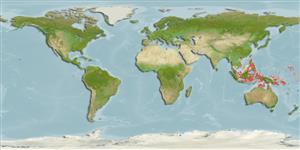>
Blenniiformes (Blennies) >
Blenniidae (Combtooth blennies) > Salariinae
Etymology: Ecsenius: Greek, exenios, -os, -on = uncontrolled, immoderate.
More on authors: Chapman & Schultz.
Environment: milieu / climate zone / depth range / distribution range
Ecología
marino asociado a arrecife; rango de profundidad 1 - 12 m (Ref. 90102). Tropical; 20°N - 15°S
Distribución
Países | Áreas FAO | Ecosistemas | Ocurrencias, apariciones | Point map | Introducciones | Faunafri
Western Pacific: Philippines, Indonesia, Northern Australia, Papua New Guinea, and the Solomon Islands.
Tamaño / Peso / Age
Maturity: Lm ? range ? - ? cm
Max length : 5.0 cm TL macho / no sexado; (Ref. 48636)
Two forms: the true species has a yellow body, blue head and yellow iris; the dusky form (rarely all yellow), with pale blue-white iris, yellow back and tail. Both forms share a black anal spot and have similar meristics (Ref. 48636).
Found in small groups in live corals of lagoons and sheltered coastal reefs at 1-15 m deep (Ref. 90102). In Papua New Guinea, various individuals were seen swimming around large coral heads on reef slopes and would not rest on the corals like those seen in Indonesia. Oviparous. Eggs are demersal and adhesive (Ref. 205), and are attached to the substrate via a filamentous, adhesive pad or pedestal (Ref. 94114). Larvae are planktonic, often found in shallow, coastal waters (Ref. 94114). It seems that the Indonesian and Philippines form may represent a new species (Ref. 48636).
Life cycle and mating behavior
Madurez | Reproducción | Puesta | Huevos | Fecundidad | Larva
Oviparous, distinct pairing (Ref. 205).
Springer, V.G., 1988. The Indo-Pacific blenniid fish genus Ecsenius. Smithson. Contrib. Zool. (465):134 p. (Ref. 5296)
IUCN Red List Status (Ref. 130435)
Threat to humans
Harmless
Human uses
Acuario: Comercial
Más información
ReferenciasAcuiculturaPerfil de acuiculturaRazasGenéticaElectrophoresesheritabilidadEnfermedadesProcesamientoNutrientsMass conversion
ColaboradoresImágenesStamps, Coins Misc.SonidosCiguateraVelocidadTipo de nataciónSuperficie branquialOtolitosCerebrosVisión
Herramientas
Special reports
Download XML
Fuentes de Internet
Estimates based on models
Preferred temperature (Ref.
123201): 28 - 29.3, mean 28.8 °C (based on 891 cells).
Phylogenetic diversity index (Ref.
82804): PD
50 = 0.5000 [Uniqueness, from 0.5 = low to 2.0 = high].
Bayesian length-weight: a=0.00741 (0.00335 - 0.01640), b=3.02 (2.83 - 3.21), in cm total length, based on LWR estimates for this (Sub)family-body shape (Ref.
93245).
Nivel trófico (Ref.
69278): 2.0 ±0.00 se; based on food items.
Resiliencia (Ref.
120179): Alto, población duplicada en un tiempo mínimo inferior a 15 meses (Preliminary K or Fecundity.).
Fishing Vulnerability (Ref.
59153): Low vulnerability (10 of 100).
Nutrients (Ref.
124155): Calcium = 272 [131, 542] mg/100g; Iron = 1.18 [0.63, 2.20] mg/100g; Protein = 17.7 [16.5, 18.9] %; Omega3 = 0.0883 [, ] g/100g; Selenium = 24.7 [10.2, 61.5] μg/100g; VitaminA = 115 [26, 496] μg/100g; Zinc = 3.64 [2.28, 5.53] mg/100g (wet weight);
